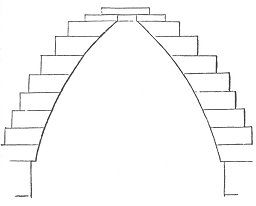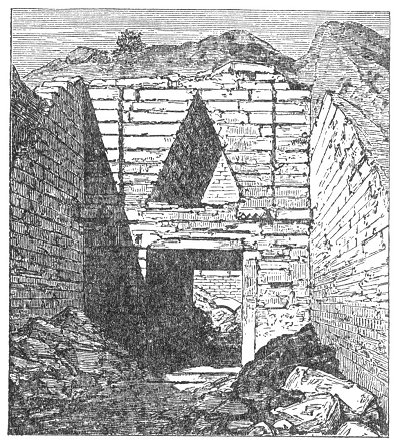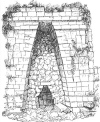
Sacred Texts Atlantis Index Previous Next
Buy this Book at Amazon.com


Atlantis, the Antediluvian World, by Ignatius Donnelly, [1882], at sacred-texts.com
THE western shores of Atlantis were not far distant from the West India Islands; a people possessed of ships could readily pass from island to island until they reached the continent. Columbus found the natives making such voyages in open canoes. If, then, we will suppose that there was no original connection between the inhabitants of the main-land and of Atlantis, the commercial activity of the Atlanteans would soon reveal to them the shores of the Gulf. Commerce implies the plantation of colonies; the trading-post is always the nucleus of a settlement; we have seen this illustrated in modern times in the case of the English East India Company and the Hudson Bay Company. We can therefore readily believe that commercial intercourse between Atlantis and Yucatan, Honduras and Mexico, created colonies along the shores of the Gulf which gradually spread into the interior, and to the high table-lands of Mexico. And, accordingly, we find, as I have already shown, that all the traditions of Central America and Mexico point to some country in the East, and beyond the sea, as the source of their first civilized people; and this region, known among them as "Aztlan," lived in the memory of the people as a beautiful and happy land, where their ancestors had dwelt in peace for many generations.
Dr. Le Plongeon, who spent four years exploring Yucatan, says:
"One-third of this tongue (the Maya) is pure Greek. Who brought the dialect of Homer to America? or who took to Greece that of the Mayas? Greek is the offspring of the Sanscrit. Is Maya? or are they coeval? . . . The Maya is not devoid of words from the Assyrian."
That the population of Central America (and in this term I include Mexico) was at one time very dense, and had attained to a high degree of civilization, higher even than that of Europe in the time of Columbus, there can be no question; and it is also probable, as I have shown, that they originally belonged to the white race. Dêsirè Charnay, who is now exploring the ruins of Central America, says (North American Review, January, 1881, p. 48), "The Toltecs were fair, robust, and bearded. I have often seen Indians of pure blood with blue eyes." Quetzalcoatl was represented as large, "with a big head and a heavy beard." The same author speaks (page 44) of "the ocean of ruins all around, not inferior in size to those of Egypt" At Teotihuacan he measured one building two thousand feet wide on each side, and fifteen pyramids, each nearly as large in the base as Cheops. "The city is indeed of vast extent . . . the whole ground, over a space of five or six miles in diameter, is covered with heaps of ruins--ruins which at first make no impression, so complete is their dilapidation." He asserts the great antiquity of these ruins, because be found the very highways of the ancient city to be composed of broken bricks and pottery, the débris left by earlier populations. "This continent," he says (page 43), "is the land of mysteries; we here enter an infinity whose limits we cannot estimate. . . . I shall soon have to quit work in this place. The long avenue on which it stands is lined with ruins of public buildings and palaces, forming continuous lines, as in the streets of modern cities. Still, all these edifices and halls were as nothing compared with the vast substructures which strengthened their foundations."
We find the strongest resemblances to the works of the ancient European races: the masonry is similar; the cement is the same; the sculptures are alike; both peoples used the arch; in both continents we find bricks, glassware, and even porcelain (North American Review, December, 1880, pp. 524, 525), "with blue figures on a white ground;" also bronze composed of the same elements of copper and tin in like proportions; coins made of copper, round and T-shaped, and even metallic candlesticks.
Dêsirè Charnay believes that he has found in the ruins of Tula the bones of swine, sheep, oxen, and horses, in a fossil state, indicating an immense antiquity. The Toltecs possessed a pure and simple religion, like that of Atlantis, as described by Plato, with the same sacrifices of fruits and flowers; they were farmers; they raised and wove cotton; they cultivated fruits; they used the sign of the Cross extensively; they cut and engraved precious stones; among their carvings have been found representations of the elephant and the lion, both animals not known in America. The forms of sepulture were the same as among the ancient races of the Old World; they burnt the bodies of their great men, and enclosed the dust in funeral urns; some of their dead were buried in a sitting position, others reclined at full length, and many were embalmed like the Egyptian mummies.
When we turn to Mexico, the same resemblances present themselves.
The government was an elective monarchy, like that of Poland, the king being selected from the royal family by the votes of the nobles of the kingdom. There was a royal family, an aristocracy, a privileged priesthood, a judiciary, and a common people. Here we have all the several estates into which society in Europe is divided.
There were thirty grand nobles in the kingdom, and the vastness of the realm may be judged by the fact that each of these could muster one hundred thousand vassals from their
own estates, or a total of three millions. And we have only to read of the vast hordes brought into the field against Cortez to know that this was not an exaggeration.
They even possessed that which has been considered the crowning feature of European society, the feudal system. The nobles held their lands upon the tenure of military service.
But the most striking feature was the organization of the judiciary. The judges were independent even of the king, and held their offices for life. There were supreme judges for the larger divisions of the kingdom, district judges in each of the provinces, and magistrates chosen by the people throughout the country.
There was also a general legislative assembly, congress, or parliament, held every eighty days, presided over by the king, consisting of all the judges of the realm, to which the last appeal lay
"The rites of marriage," says Prescott, "were celebrated with as much formality as in any Christian country; and the institution was held in such reverence that a tribunal was instituted for the sole purpose of determining questions relating to it. Divorces could not be obtained until authorized by a sentence of the court, after a patient hearing of the parties."
Slavery was tolerated, but the labors of the slave were light, his rights carefully guarded, and his children were free. The slave could own property, and even other slaves.
Their religion possessed so many features similar to those of the Old World, that the Spanish priests declared the devil had given them a bogus imitation of Christianity to destroy their souls. "The devil," said they, "stole all he could."
They had confessions, absolution of sins, and baptism. When their children were named, they sprinkled their lips and bosoms with water, and "the Lord was implored to permit the holy drops to wash away the sin that was given it before the foundation of the world."
The priests were numerous and powerful. They practised
fasts, vigils, flagellations, and many of them lived in monastic seclusion.
The Aztecs, like the Egyptians, had progressed through all the three different modes of writing--the picture-writing, the symbolical, and the phonetic. They recorded all their laws, their tribute-rolls specifying the various imposts, their mythology, astronomical calendars, and rituals, their political annals and their chronology. They wrote on cotton-cloth, on skins prepared like parchment, on a composition of silk and gum, and on a species of paper, soft and beautiful, made from the aloe. Their books were about the size and shape of our own, but the leaves were long strips folded together in many folds.
They wrote poetry and cultivated oratory, and paid much attention to rhetoric. They also had a species of theatrical performances.
Their proficiency in astronomy is thus spoken of by Prescott:
"That they should be capable of accurately adjusting their festivals by the movements of the heavenly bodies, and should fix the true length of the tropical year with a precision unknown to the great philosophers of antiquity, could be the result only of a long series of nice and patient observations, evincing no slight progress in civilization."
"Their women," says the same author, "are described by the Spaniards as pretty, though with a serious and rather melancholy cast of countenance. Their long, black hair might generally be seen wreathed with flowers, or, among the richer people, with strings of precious stones and pearls from the Gulf of California. They appear to have been treated with much consideration by their husbands; and passed their time in indolent tranquillity, or in such feminine occupations as spinning, embroidery, and the like; while their maidens beguiled the hours by the rehearsal of traditionary tales and ballads.
"Numerous attendants of both sexes waited at the banquets. The balls were scented with perfumes, and the courts strewed with odoriferous herbs and flowers, which were distributed in profusion among the guests as they arrived. Cotton napkins and ewers of water were placed before them as they took their
seats at the board. Tobacco was them offered, in pipes, mixed with aromatic substances, or in the form of cigars inserted in tubes of tortoise-shell or silver. It is a curious fact that the Aztecs also took the dried tobacco leaf in the pulverized form of snuff.
"The table was well supplied with substantial meats, especially game, among which the most conspicuous was the turkey. Also, there were found very delicious vegetables and. fruits of every variety native to the continent. Their palate was still further regaled by confections and pastry, for which their maize-flower and sugar furnished them ample materials. The meats were kept warm with chafing-dishes. The table was ornamented

COMMON FORM OF ARCH, CENTRAL AMERICA.
with vases of silver and sometimes gold of delicate workmanship. The favorite beverage was chocolatl, flavored with vanilla and different spices. The fermented juice of the maguey, with a mixture of sweets and acids, supplied various agreeable drinks of different degrees of strength."
It is not necessary to describe their great public works, their floating gardens, their aqueducts, bridges, forts, temples, palaces,

SECTION OF THE TREASURE-HOUSE OF ATREUS AT MYCENAE.
and gigantic pyramids, all ornamented with wonderful statuary.
We find a strong resemblance between the form of arch used in the architecture of Central America and that of the oldest buildings of Greece. The Palenque arch is made by the gradual overlapping of the strata of the building, as shown in the accompanying cut from Baldwin's "Ancient America," page 100. It was the custom of these ancient architects to fill in the arch itself with masonry, as shown in the picture

Click to enlarge
ARCH OF LAS MONJAS, PALENQUE, CENTRAL AMERICA.
on page 355 of the Arch of Las Monjas, Palenque. If now we took at the representation of the "Treasure-house of Atreus" at Mycenæ, on page 354--one of the oldest structures in Greece--we find precisely the same form of arch, filled in in the same way.
Rosengarten ("Architectural Styles," p. 59) says:
"The base of these treasure-houses is circular, and the covering of a dome shape; it does not, however, form an arch, but courses of stone are laid horizontally over one another in such a way that each course projects beyond the one below it, till the space at the highest course becomes so narrow that a single stone covers it. Of all those that have survived to the present day the treasure-house at Atreus is the most venerable."
The same form of arch is found among the ruins of that interesting people, the Etruscans.
"Etruscan vaults are of two kinds. The more curious and probably the most ancient are false arches, formed of horizontal courses of stone, each a little overlapping the other, and carried on until the aperture at the top could be closed by a single superincumbent slab. Such is the construction of the Regulini-Galassi vault, at Cervetere, the ancient Cære." (Rawlinson's "Origin of Nations," p. 117.)
It is sufficient to say, in conclusion, that Mexico, under European rule, or under her own leaders, has never again risen to her former standard of refinement, wealth, prosperity, or civilization.